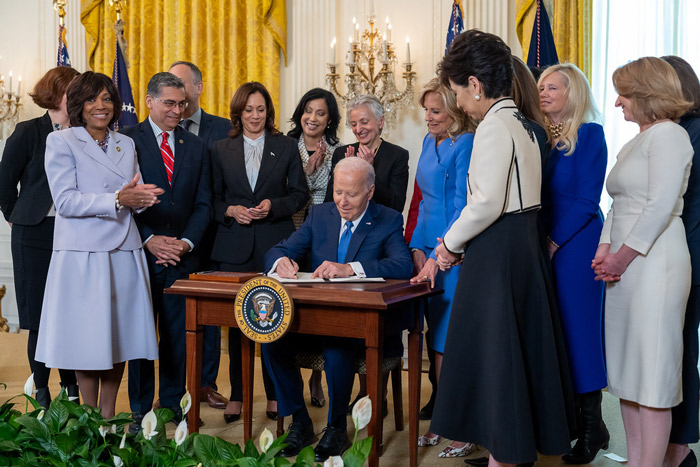AIDS Amnesia
Dwindling political support for global and national HIV programs will put women’s lives at risk.
By Susan J. Blumenthal, MD, MPA, and Lauren Brunet, MPH
This op-ed originally appeared in The Hill, published on June 13, 2024.
A recent report from the Centers for Disease Control and Prevention found decreases in HIV infections overall in the U.S., but not for women.

At the beginning of the AIDS epidemic, the scientific and medical communities failed to recognize that women could be seriously affected by the disease. As a result, they were excluded from clinical trials for HIV and AIDS treatment and preventive interventions. This major public health oversight led to a rapid rise in the number of HIV cases among women worldwide. Women now represent 54 percent of people living with HIV globally, and 24 percent in America.
Thankfully, significant investments in research over the last four decades have produced lifesaving discoveries in HIV prevention and treatment.
Pre-exposure prophylaxis is a type of medication that can reduce the risk of acquiring HIV by 99 percent if taken as prescribed. And today, life expectancy for people living with HIV on antiretroviral therapy is similar to those without HIV. Additionally, consistent access to antiretroviral therapy allows people to reach viral suppression, which virtually eliminates their risk of transmitting HIV to others.
Since 2010, the number of annual HIV infections has decreased by 33 percent globally and by 12 percent in the U.S.
Unfortunately, this remarkable progress has led to “AIDS amnesia,” causing many people to mistakenly believe that HIV is no longer a major health threat. This misconception has resulted in declining political will to combat the disease, posing a risk of HIV resurgence.
The President’s Emergency Plan for AIDS Relief (PEPFAR) was established in 2003 by President George W. Bush to bring HIV services to some of the hardest-hit areas of the world. This program represents the largest investment that any country has made to fight a single disease in history. Over the past 20 years, PEPFAR has saved 25 million lives in 55 nations, prevented mother-to-child HIV transmission for 5.5 million babies, and brought HIV preventive services to 2.5 million young women in 2023.
Yet bipartisan congressional support for PEPFAR has stagnated. Funding for the program was recently reauthorized for just one year instead of the traditional five years it has enjoyed since 2003. Notably, only 10 percent of the current Congress was in office when the initiative was launched. This limited reauthorization poses a significant challenge for countries that rely on predictable funding to sustain large-scale HIV programs and build health system capacity to rapidly respond to public health threats. Indeed, PEPFAR laid a foundation that was leveraged to help mobilize an international response to COVID-19. Divestment from the program could leave the world vulnerable to new and emerging pandemics.

Sadly, AIDS amnesia is widespread in America.
The Ending the HIV Epidemic initiative was established by the Trump administration in 2019 to help the U.S. reach the ambitious goal of reducing HIV diagnoses by 90 percent by 2030. The initiative provides resources to communities with the highest rates of new diagnoses and addresses socioeconomic disparities in HIV outcomes by strengthening initiatives such as the Ryan White HIV/AIDS program, which provides HIV services to uninsured individuals. Nearly 9 out of 10 women participating in Ryan White achieved viral suppression in 2022. Since 2018, HIV incidence has decreased by 16 percent in the South, which includes over half of the jurisdictions participating in the Ending the HIV Epidemic program.
This progress is in peril due to an apparent lack of political support.
The program was never fully funded by Congress, and the U.S. House of Representatives moved this year to eliminate support. Furthermore, despite important gains in HIV prevention, significant disparities persist between jurisdictions. Women living in the South have higher rates of HIV infection than those in any other region in America. Southern Black women are 14 times more likely to be living with HIV than their white neighbors.
Yet some states have chosen to opt out of the program altogether. Last year, Tennessee, home to Shelby County, where the rate of HIV diagnoses is twice the national average, refused Ending the HIV Epidemic and CDC HIV surveillance funding. If other states were to follow suit, this would threaten women’s health across America as clinics that stand to lose critical funding often serve as an entry point to care for women at risk for HIV and are the only source of healthcare for many female patients.
A resurgence of HIV is inevitable if this AIDS amnesia persists. President Biden’s recent executive order to advance women’s health research is an important step forward in ending AIDS, given that only 17 percent of participants in clinical trials for an HIV cure are women. We must also intensify other actions, both domestically and abroad, by significantly investing in public-sector and private-sector initiatives targeting HIV, increasing funding for research that investigates sex differences over the lifespan, and by re-establishing the five-year reauthorization for PEPFAR.
Rear Admiral Susan Blumenthal, MD, MPA, former US Assistant Surgeon General, is the Senior Medical and Policy Advisor at amfAR, The Foundation for AIDS Research and a Visiting Professor at the MIT Media Lab. Her work has included a focus on HIV/AIDS since the beginning of the epidemic in the United States in the early 1980s.
Lauren Brunet, MPH, is a former Allan Rosenfield Public Policy Fellow at amfAR.
Click Here to read more from the July 2024 issue of amfAR INNOVATIONS.
Share This:
